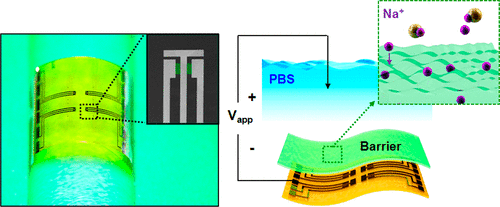Our official English website, www.x-mol.net, welcomes your feedback! (Note: you will need to create a separate account there.)
Ultrathin Trilayer Assemblies as Long-Lived Barriers against Water and Ion Penetration in Flexible Bioelectronic Systems
ACS Nano ( IF 17.1 ) Pub Date : 2018-10-03 00:00:00 , DOI: 10.1021/acsnano.8b05552 Enming Song 1, 2 , Rui Li 3 , Xin Jin 4 , Haina Du 2 , Yuming Huang 2 , Jize Zhang 2 , Yu Xia 2 , Hui Fang 5 , Yoon Kyeung Lee 6 , Ki Jun Yu 7 , Jan-Kai Chang 1 , Yongfeng Mei 8 , Muhammad A. Alam 4 , Yonggang Huang 9 , John A. Rogers 1, 2, 10
ACS Nano ( IF 17.1 ) Pub Date : 2018-10-03 00:00:00 , DOI: 10.1021/acsnano.8b05552 Enming Song 1, 2 , Rui Li 3 , Xin Jin 4 , Haina Du 2 , Yuming Huang 2 , Jize Zhang 2 , Yu Xia 2 , Hui Fang 5 , Yoon Kyeung Lee 6 , Ki Jun Yu 7 , Jan-Kai Chang 1 , Yongfeng Mei 8 , Muhammad A. Alam 4 , Yonggang Huang 9 , John A. Rogers 1, 2, 10
Affiliation

|
Biomedical implants that incorporate active electronics and offer the ability to operate in a safe, stable fashion for long periods of time must incorporate defect-free layers as barriers to biofluid penetration. This paper reports an engineered material approach to this challenge that combines ultrathin, physically transferred films of silicon dioxide (t-SiO2) thermally grown on silicon wafers, with layers of hafnium oxide (HfO2) formed by atomic layer deposition and coatings of parylene (Parylene C) created by chemical vapor deposition, as a dual-sided encapsulation structure for flexible bioelectronic systems. Accelerated aging tests on passive/active components in platforms that incorporate active, silicon-based transistors suggest that this trilayer construct can serve as a robust, long-lived, defect-free barrier to phosphate-buffered saline (PBS) solution at a physiological pH of 7.4. Reactive diffusion modeling and systematic immersion experiments highlight fundamental aspects of water diffusion and hydrolysis behaviors, with results that suggest lifetimes of many decades at physiological conditions. A combination of ion-diffusion tests under continuous electrical bias, measurements of elemental concentration profiles, and temperature-dependent simulations reveals that this encapsulation strategy can also block transport of ions that would otherwise degrade the performance of the underlying electronics. These findings suggest broad utility of this trilayer assembly as a reliable encapsulation strategy for the most demanding applications in chronic biomedical implants and high-performance flexible bioelectronic systems.
中文翻译:

超薄三层组件作为柔性生物电子系统中对水和离子渗透的长寿命屏障
集成了有源电子设备并能够以安全,稳定的方式长时间运行的生物医学植入物,必须包含无缺陷的层作为生物流体渗透的屏障。本文报告了一种工程材料方法来应对这一挑战,该方法将在硅晶片上热生长的超薄,物理转移的二氧化硅(t-SiO 2)薄膜与氧化f (HfO 2)层相结合)是通过原子层沉积和化学气相沉积产生的聚对二甲苯(Parylene C)涂层形成的,作为柔性生物电子系统的双面封装结构。在集成了基于硅的有源晶体管的平台上对无源/有源组件进行的加速老化测试表明,这种三层构造可在生理pH值下充当磷酸盐缓冲盐水(PBS)溶液的坚固,长寿命,无缺陷的屏障7.4。反应扩散建模和系统的浸入实验突出了水扩散和水解行为的基本方面,其结果表明在生理条件下的寿命长达数十年。连续电偏压下的离子扩散测试,元素浓度分布的测量,与温度有关的仿真表明,这种封装策略还可以阻止离子的传输,否则会降低底层电子设备的性能。这些发现表明,这种三层组件作为可靠的封装策略具有广泛的用途,可用于慢性生物医学植入物和高性能柔性生物电子系统中最苛刻的应用。
更新日期:2018-10-03
中文翻译:

超薄三层组件作为柔性生物电子系统中对水和离子渗透的长寿命屏障
集成了有源电子设备并能够以安全,稳定的方式长时间运行的生物医学植入物,必须包含无缺陷的层作为生物流体渗透的屏障。本文报告了一种工程材料方法来应对这一挑战,该方法将在硅晶片上热生长的超薄,物理转移的二氧化硅(t-SiO 2)薄膜与氧化f (HfO 2)层相结合)是通过原子层沉积和化学气相沉积产生的聚对二甲苯(Parylene C)涂层形成的,作为柔性生物电子系统的双面封装结构。在集成了基于硅的有源晶体管的平台上对无源/有源组件进行的加速老化测试表明,这种三层构造可在生理pH值下充当磷酸盐缓冲盐水(PBS)溶液的坚固,长寿命,无缺陷的屏障7.4。反应扩散建模和系统的浸入实验突出了水扩散和水解行为的基本方面,其结果表明在生理条件下的寿命长达数十年。连续电偏压下的离子扩散测试,元素浓度分布的测量,与温度有关的仿真表明,这种封装策略还可以阻止离子的传输,否则会降低底层电子设备的性能。这些发现表明,这种三层组件作为可靠的封装策略具有广泛的用途,可用于慢性生物医学植入物和高性能柔性生物电子系统中最苛刻的应用。



























 京公网安备 11010802027423号
京公网安备 11010802027423号